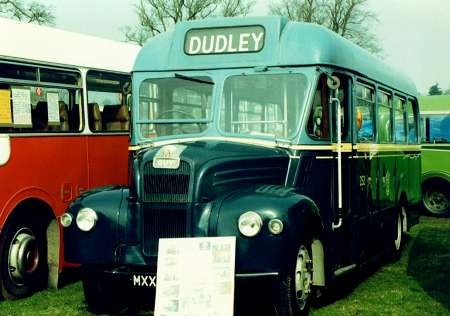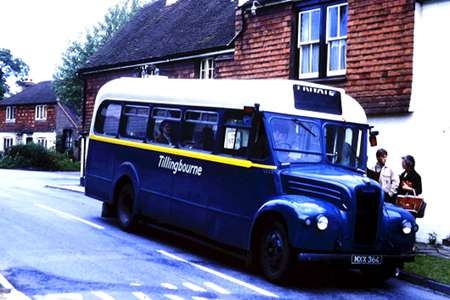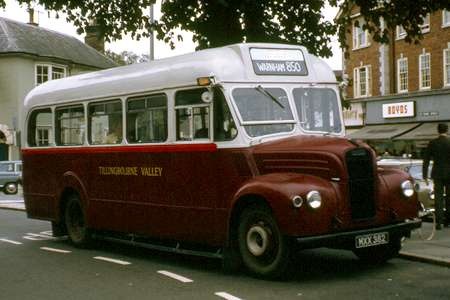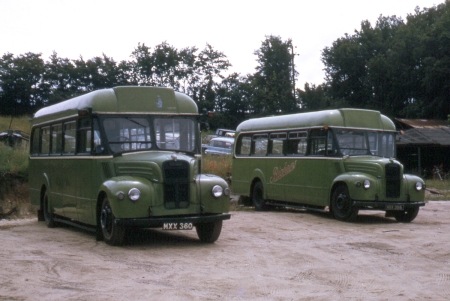Bickers of Coddenham
1953
Guy GS
ECW B26F
In 1969 Bickers bought two Guy GS buses, MXX 356 and 360 which were GS56 and GS60 in the London Transport fleet. Here is a picture of them in 1975. The following year they were both sold into preservation, though I believe that neither has been seen about in the last few years. Unless you know different that is, you know how to get in touch.
Photograph and Copy contributed by Roger Cox
21/12/11 – 20:05
Give me a big engined AEC or Leyland any day but these big hearted babies are full of character and deserve their place among the preservation greats. These two look a little mat paint/MOD and well used. Even more testimony to their initially build quality – but they look even better in LT/Country green, gleaming on a running day.
The modern day equivalent is a Mercedes Vario or IVECO Daily. In the words of one of my choir, who spent his professional life working for Tilling subsidiaries, “I know which ones will last longer.”
David Oldfield
22/12/11 – 06:24
I drove the Tillingbourne examples of the GS in the Guildford area, and I found them to be delightfully robust, positive little machines, though the clanky sounding Perkins P6 engine didn’t impress me very much. The GS was another of those buses with a “right to left” wrong way round gearbox, and I have always wondered who made it. Was it a Guy box, or something from another maker?
Also, was it yet another manifestation of London Transport’s flat earth outlook that led it to commission Guy to manufacture a specially designed 26 seat model? Dennis had been producing successful buses of this type for years, and the LGOC had purchased a fleet of around forty Darts in the 1930s. The logical move for LT in the 1950s would surely have been to obtain a P6 powered version of the established Falcon. The GS was (indeed still is – there are lots still around) a really good little bus, but I remain perplexed that it was ever ordered in the first place.
Roger Cox
22/12/11 – 06:25
GS’s were certainly a hybrid ‘special. Based on a modified Guy Vixen chassis, it sported a Perkins P6 indirect-injection, 65 bhp engine, with 4-speed crash gearbox. It was a rare example of London Transport buying an ECW body, which it was supposed to buy in preference to other makes. However, off-hand, I can only think of RFW’s as the other example in post-war years. Even so, LTE put their stamp on it, as it bore a remarkable resemblance to the RF body at the rear.
Chris Hebbron
22/12/11 – 06:26
There are some others from the same batch which survived for a fair time but not in a very good way. See them here www.travellerhomes.co.uk/
At least they had long and useful lives and as David says, they are rather attractive and purposeful souls.
Richard Leaman
22/12/11 – 08:25
As Roger says LT always had some rather odd ideas – the prewar rear engined Leyland CRs spring to mind with only twenty seats AND a conductor !! I too have always admired the little GS class, surely one of the most handsome small buses ever.
Chris Youhill
23/12/11 – 07:00
The CR’s were designed for OMO, but, post-war, with the huge increase in passengers, those OMO routes in Central Area were either abandoned/absorbed into other, busier routes or served by full-sized buses, rendering these ‘babies’ surplus. However, they were spread about and used, as a last resort, to replace full-sized vehicles which had failed, hence the two-man crews. Ill-suited to intensive work, and under-developed, they often crumpled under the strain. I made one journey, on just one, in such a situation. It coped!
Chris Hebbron
23/12/11 – 09:37
Thanks for that Chris H – that’s something I never knew despite owning much bookware about LT – you’re never too old to learn as they say.
Chris Youhill
23/12/11 – 12:11
A nice coincidence is that Leyland’s light 6-cyl diesel used in the CR had the same bore and stroke (3.5″ x 5.0″) as the Perkins P6 used by Guy in the GS. Both engines were indirect injection and shared that light tinkling “threepenny bits” combustion note. The only ride I’ve ever had in a CR was at Cobham (held at Chobham) a few years ago, and the engine sound was remarkably Perkins-like. Another thing I learnt that day: the big-diameter rear hub houses not a double-reduction gear but a universal joint, so the CR evidently didn’t have a beam axle.
Ian Thompson
24/12/11 – 06:36
Douglas Corporation ran some Guy Gs style buses with Mulliner bodywork. They were fitted with large upright destination screens front and rear. This gave rise to their nickname of Wolsey’s camels after the then manager. Douglas also bought what I think are the only Leyland Comets in municipal service.
Chris Hough
24/12/11 – 06:40
Chris Hebbron – re LT buying ECW bodies, there was also SLT 59, (CRL4/RMC4), the first Green Line Routemaster.
Bob Gell
24/12/11 – 06:41
One unusual feature of the CR was a De Dion rear axle, with a universal joint at both ends of the half-shafts. I’ve no idea why it was fitted, maybe to produce a more stable ride for the engine at the rear. Here is a photo and diagram of how it worked (These axles were made from the 1890’s into this century without much change. Sports cars had them, but production cars like the Rover 2000 had it, too). See //www.light-motor-cars.co.uk/
Chris Hebbron
24/12/11 – 09:54
Thx, Bob, for the titbit on SLT 59. ECW must have struggled to meet that order on time! I always thought it looked smart with its framed side lower-deck windows, but had a feeling that the full-width lower rear window looked as if it wasn’t centred properly, or was that my imagination?
Chris Hebbron
24/12/11 – 13:12
There are pictures of SLT 59 on the web including www.londonbuspage.com/ which has this and KGJ 603D which is obligingly pictured from the rear with what also appears to be an off-centre rear window: is this to stiffen the corner by the rear door?
Does anyone know anything about the ECW (presumably) system on the VR which sucked all the cig ends and packets out of the upper deck through a port at the back? Now that’s innovation….
Joe
10/11/12 – 06:51
In the 1980s I owned GS 36 it was a joy to drive once you got used to the gearbox, double de clutch comes to mind, sorry I sold it.
Stuart
04/01/13 – 08:51

On 2/5/10 I took the above picture although I cannot remember where I took it. As I had retired to Cornwall in 2008 and was visiting all the shows I can only assume that it was in Cornwall. I used your site to try and identify the model and any other details available and when I selected the Guy GS model found a photo of 2 buses under the heading of Bickers of Coddenham and comments that the picture was from 1975 and with registration numbers MXX 356 and MXX 360. It further stated that the buses had been sold into preservation but not seen in the last few years. As the photo I took has MXX on its plate unfortunately the numbers are hidden. I just thought that it may possibly be one the buses in a new livery so I forwarded it for any information possible.
Warren Farrer
04/01/13 – 13:03
This bus is in the distinctive livery of West Bromwich Corporation, and you can just make out the fleet number 252. The registration would be MXX 340. It was acquired from London Transport in 1961.
Alan Murray-Rust
11/02/15 – 14:03

This is all new to me. I am enjoying the various photos and comments. On the Home page there are photos of the Guy Specials. Although the original contributions were some 3 years ago, the attached may be of interest showing the only GS painted into Tillingbourne blue seen at Rusper on the service to Horsham on 1. 7. 1972. The driver may well be your contributor Roger Cox. Thanks to the driver for the ride.
Keith Newton
12/02/15 – 06:35
Welcome, Keith and thx for your photo. It certainly looks very odd out of LT colours!
Chris Hebbron
12/02/15 – 06:35
No, it’s not me, Keith. MXX 364, ex GS64, was the only GS painted in the then new blue Tillingbourne livery shown in your picture. It was out stationed for a time at Horsham (on a rotational basis with one of the SUs) for the Horsham-Rusper circular route. Although I did drive the SU4LAs on this service, I didn’t take GS64 in its new livery. This was the last GS bought by Tillingbourne (in April 1971) and the last to be operated, being withdrawn in October 1972.
Roger Cox
 Vehicle reminder shot for this posting
Vehicle reminder shot for this posting
19/02/15 – 07:35

Here is another Tillingbourne GS, MXX 382, ex GS82, seen in Horsham Carfax when ‘On Hire’ to North Downs Rural Transport in 1971. It is in the revised livery initially adopted by Trevor Brown in September 1970 when he took over Tillingbourne Valley from the Trice family who had run the business since 1924. Later, the blue livery shown above in Keith’s picture replaced the maroon, though MXX 382 was never so repainted, being withdrawn in March 1972. North Downs itself, after struggling with low revenues and maintenance issues, finally expired on 17 April 1972, whereupon the Horsham services became part of the Tillingbourne network.
Roger Cox
19/02/15 – 10:34
The history of all the London Transport GS Class can be found at the excellent “Ian’s Bus Stop” website at this link: www.countrybus.org/GS/GSa
Chris Hebbron
24/02/15 – 14:13
David Call is right. Stage was the highest category and the most demanding. Express was in the middle and the lowest category was contract. I worked in the Metropolitan Traffic Area’s PSV licensing team in 1963 and 1964, and I handled very few contract PSV licences.
One oddity about the Metropolitan Traffic Area was that it did not handle licensing of drivers or conductors, which was handled by the Public Carriage Office of the Metropolitan Police. Another was that London Transport not only trained their own drivers, but tested them as well!
David Wragg
24/02/15 – 16:12
My original PSV was passed in London in 1967. In 1972 I moved back to Manchester and when my licence came up for renewal I had to surrender my ‘N’ badge for a ‘CC’ one. The new one was a bit slow coming so I went along to the office in Manchester to enquire why.
It turned out that the Civil Service Union was on a work-to-rule and they would not issue the new one until they received the 2/6d. deposit on my old one from London. When I protested that I could not work (the law stated that it had to be worn) because they did not trust the Metropolitan Police Commissioner to return my 2/6d the supervisor was called. After some argument, the supervisor’s supervisor was called and nobody could think of a rule that stopped my paying again. They kindly allowed me to do this and promised they would refund me when they received the original deposit. Still waiting… (Maybe I should write to the Prime Minister and Sir Bernard whatsit-Howe about why the south is so much richer than the north!)
John Hodkinson
25/02/15 – 06:02
David Wragg says it was ”an oddity for London Transport to test their own Drivers”
Not so, Designated Examiners were common practice in the larger Companies, and Municipal Undertakings, and still are.
There was a specified number of Drivers who had to be employed, I think 300, to qualify for one, and the Examiner was not to be the same person as the one who undertook the Training.
This was to alleviate the pressure off the Ministry of Transport.
In the past there were no separate Department of Transport Driving Examiners, PSV Tests were carried out by the Area Certifying Officer (The Ministry Man).
He would re-certify a few vehicles in the morning, and then carry out a few PSV Driving Tests in the afternoon, or visa versa. At Oldham Corporation I seem to recall it was a Tuesday.
Also you did not get a pass or fail off him, and no pass certificate. He just said he would make his recommendation to The Traffic Commissioner and you would hear in due course.
You did not know if you had passed until your Licence and Badge arrived.
Stephen Howarth

Leave a Reply